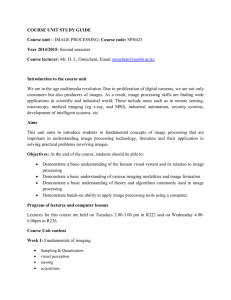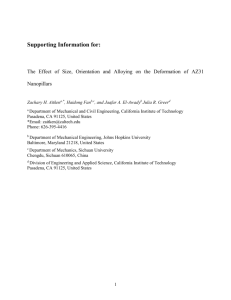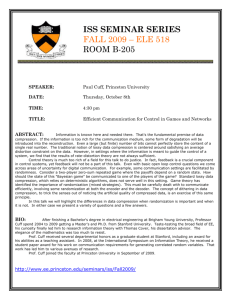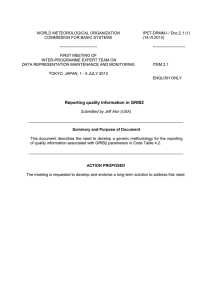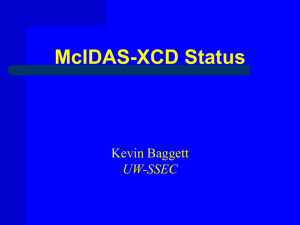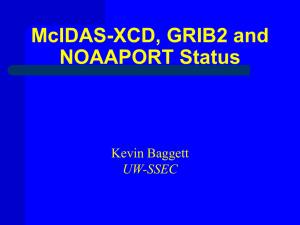Doc. 2.1.2(1)
advertisement
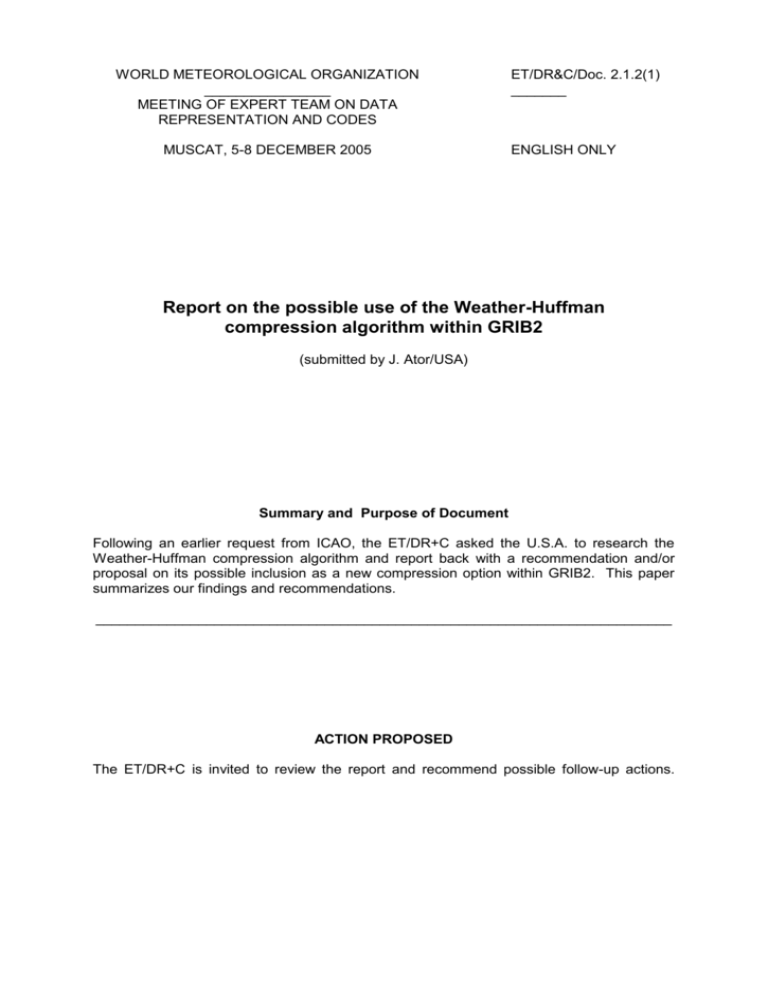
WORLD METEOROLOGICAL ORGANIZATION ________________ MEETING OF EXPERT TEAM ON DATA REPRESENTATION AND CODES MUSCAT, 5-8 DECEMBER 2005 ET/DR&C/Doc. 2.1.2(1) _______ ENGLISH ONLY Report on the possible use of the Weather-Huffman compression algorithm within GRIB2 (submitted by J. Ator/USA) Summary and Purpose of Document Following an earlier request from ICAO, the ET/DR+C asked the U.S.A. to research the Weather-Huffman compression algorithm and report back with a recommendation and/or proposal on its possible inclusion as a new compression option within GRIB2. This paper summarizes our findings and recommendations. _________________________________________________________________________ ACTION PROPOSED The ET/DR+C is invited to review the report and recommend possible follow-up actions. BACKGROUND Based upon a prior discussion topic presented to ICAO by members of the U.S. Federal Aviation Administration (FAA) and subsequently forwarded by ICAO to the WMO ET/DR+C, the U.S. was asked to investigate and analyze the Weather-Huffman (WH) compression algorithm as a possible new compression option within GRIB2. A study conducted in early 2002 had apparently shown some great advantages in compression savings with the use of WH vs. other compression schemes available within BUFR and GRIB2, and it was noted that such results were very promising given the need for aircraft ground controllers to be able to exchange image information with pilots in the cockpit using as little bandwidth as possible over the ground-to-air link. DISCUSSION AND ANALYSIS With the above in mind, we contacted the U.S. Technical Information Service and obtained a copy of the document “The Weather-Huffman Method of Data Compression of Weather Images”. The document, not to mention the WH algorithm itself, were developed by the Lincoln Laboratory of the Massachusetts Institute of Technology (MIT) as part of a study contracted by ICAO and the FAA. As such, WH is not currently maintained by any internationally-recognized standards organization such as ISO or IEEE, nor are there any imminent plans to do so. This, combined with the fact that the document itself is a full 79 pages long, and therefore unable to be concisely summarized in a direct manner within the WMO Codes manual itself, seemed to right away violate the mandatory criteria for new GRIB2 compression schemes that were agreed by the ET/DR+C at our June 2004 meeting in Kuala Lumpur (re: discussion item 2.3.3). Furthermore, and while the WH algorithm and all other information in the document itself are considered “public domain”, there is no corresponding “public domain” software currently available to encode or decode WHcompressed information. Such software was developed by MIT as part of the aforementioned study; however, given that they have since licensed it for a fee to several outside organizations and do not want to alienate those customers by suddenly giving it away for free to the wider WMO community, then some other organization would have to undertake that rather complex task. Notwithstanding these immediate concerns, we nevertheless went ahead and reviewed the document on its merits, and we also worked directly with a helpful gentleman at Lincoln Laboratory to run some comparison tests of WH vs. the existing GRIB2 compression schemes JPEG2000, PNG and 1st and 2nd-order packing, using 12 canned radar reflectivity images. In all cases, the WH results were quite impressive and provided superior compression results vs. the other existing schemes, although the gentleman himself pointed out that WH was developed specifically for compression of radar reflectivity images, where values tend to increase and decrease smoothly (i.e. no abrupt jumps) and where regions of higher data values tend to be fully enclosed within regions of lower data values. In other words, WH is highly-optimized towards its intended target application and therefore not necessarily an efficient general-purpose compression algorithm. So it would be interesting to see how WH performs on other types of weather-based data such as satellite imagery and/or model output grid fields such as temperature, wind speed, etc. Such future studies might be conducted, and the folks at Lincoln Laboratory have indicated a willingness to participate, assuming that some of the above issues concerning mandatory criteria for GRIB2 compression schemes, software availability, etc. could be worked out. In the meantime, we are willing to provide additional electronic copies of the aforementioned document to any other interested parties through the ET/DR+C, and we can also provide a contact address at Lincoln Laboratory for follow-up questions or compression testing if anyone is interested to pursue this further.



